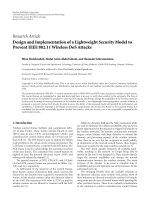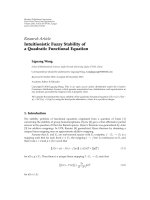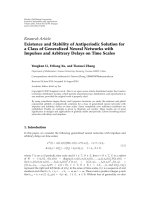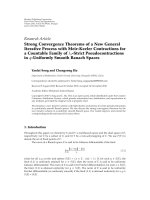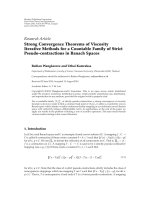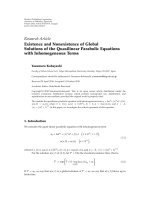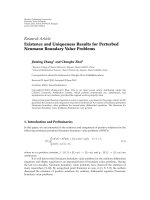báo cáo hóa học:" Research Article Existence and Multiplicity of Positive Solutions of a Boundary-Value Problem for Sixth-Order ODE with Three Parameters" pdf
Bạn đang xem bản rút gọn của tài liệu. Xem và tải ngay bản đầy đủ của tài liệu tại đây (510.13 KB, 13 trang )
Hindawi Publishing Corporation
Boundary Value Problems
Volume 2010, Article ID 878131, 13 pages
doi:10.1155/2010/878131
Research Article
Existence and Multiplicity of Positive
Solutions of a Boundary-Value Problem for
Sixth-Order ODE with Three Parameters
Liyuan Zhang and Yukun An
Nanjing University of Aeronautics and Astronautics, 29 Yudao st., Nanjing 210016, China
Correspondence should be addressed to Liyuan Zhang,
Received 13 May 2010; Accepted 14 August 2010
Academic Editor: Kanishka Perera
Copyright q 2010 L. Zhang and Y. An. This is an open access article distributed under the Creative
Commons Attribution License, which permits unrestricted use, distribution, and reproduction in
any medium, provided the original work is properly cited.
We study the existence and multiplicity of positive solutions of the following boundary-value
u1
u 0
u 1
u4 0
u4 1
problem: −u 6 − γu 4 βu − αu f t, u , 0 < t < 1, u 0
0, where f : 0, 1 × R → R is continuous, α, β, and γ ∈ R satisfy some suitable assumptions.
1. Introduction
The following boundary-value problem:
u6
Au 4
Bu
u 0
u L
Cu − f x, u
u 0
0,
u4 0
u L
0 < x < L,
u4 L
1.1
0,
where A, B, and C are some given real constants and f x, u is a continuous function on
R2 , is motivated by the study for stationary solutions of the sixth-order parabolic differential
equations
∂u
∂t
∂6 u
∂x6
A
∂4 u
∂x4
B
∂2 u
∂x2
f x, u .
1.2
This equation arose in the formation of the spatial periodic patterns in bistable systems and is
also a model for describing the behaviour of phase fronts in materials that are undergoing a
2
Boundary Value Problems
transition between the liquid and solid state. When f x, u
u−u3 , it was studied by Gardner
and Jones 1 as well as by Caginalp and Fife 2 .
If f is an even 2L-periodic function with respect to x and odd with respect to u, in
order to get the 2L-stationary spatial periodic solutions of 1.2 , one turns to study the two
points boundary-value problem 1.1 . The 2L-periodic extension u of the odd extension of the
solution u of problems 1.1 to the interval −L, L yields 2L-spatial periodic solutions of 1.2
Gyulov et al. 3 have studied the existence and multiplicity of nontrivial solutions of
BVP 1.1 . They gained the following results.
Theorem 1.1. Let f x, u : R2 → R be a continuous function and F x, u
the following assumptions are held:
H1 F x, u /u2 →
H2 0 ≤ F x, u
∞ as |u| →
ou
u
0
f x, s ds. Suppose
∞, uniformly with respect to x in bounded intervals,
as u → 0, uniformly with respect to x in bounded intervals,
2
then problem 1.1 has at least two nontrivial solutions provided that there exists a natural number
n such that P nπ/L < 0, where P ξ
ξ6 − Aξ4 Bξ2 − C is the symbol of the linear differential
6
4
Au
Bu Cu.
operator Lu u
At the same time, in investigating such spatial patterns, some other high-order
parabolic differential equations appear, such as the extended Fisher-Kolmogorov EFK
equation
∂u
∂t
−ζ
∂4 u
∂x4
∂2 u
∂x2
u − u3 ,
ζ > 0,
1.3
proposed by Coullet, Elphick, and Repaux in 1987 as well as by Dee and Van Saarlos in 1988
and Swift-Hohenberg SH equation
∂u
∂t
ρu −
1
∂2 u
∂x2
2
u − u3 ,
ρ > 0,
1.4
proposed in 1977.
In much the same way, the existence of spatial periodic solutions of both the EFK
equation and the SH equation was studied by Peletier and Troy 4 , Peletier and Rottschă fer
a
5 , Tersian and Chaparova 6 , and other authors. More precisely, in those papers, the
authors studied the following fourth-order boundary-value problem:
u4
Au
u 0
Bu
f x, u
u L
u 0
0,
u L
0 < x < L,
1.5
0.
The methods used in those papers are variational method and linking theorems.
On the other hand, The positive solutions of fourth-order boundary value problems
1.5 have been studied extensively by using the fixed point theorem of cone extension
or compression. Here, we mention Li’s paper 7 , in which the author decomposes the
fourth-order differential operator into the product of two second-order differential operators
Boundary Value Problems
3
to obtain Green’s function and then used the fixed point theorem of cone extension or
compression to study the problem.
The purpose of this paper is using the idea of 7 to investigate BVP for sixthorder equations. We will discuss the existence and multiplicity of positive solutions of the
boundary-value problem
−u 6 − γu 4
u 0
u 1
βu − αu
u 0
f t, u ,
u4 0
u 1
1.6
0 < t < 1,
u4 1
1.7
0,
and then we assume the following conditions throughout:
H1 f : 0, 1 × 0, ∞ → 0, ∞ is continuous,
H2 α, β, and γ ∈ R satisfy
3π 4 − 2γπ 2 − β > 0,
γ < 3π 2 ,
β
π4
α
π6
18αβγ − β2 γ 2
γ
< 1,
π2
1.8
27α2 − 4β3 ≤ 0.
4αγ 3
Note. The set of α, β, and γ which satisfies H2 is nonempty. For instance, if γ
then H2 holds for α : −4π 2 /27 < α < 0.
To be convenient, we introduce the following notations:
f
0
lim inf min
∞
u→0
t∈ 0,1
lim inf min
u → ∞ t∈ 0,1
0,
π 6 − γπ 4 − βπ 2 − α,
L
f
π 2, β
f t, u
u
f∞
f t, u
u
,
lim sup max
f t, u
u
,
f0
,
lim sup max
f t, u
u
.
u→∞
u→0
t∈ 0,1
t∈ 0,1
1.9
2. Preliminaries
Lemma 2.1 see 8 . Set the cubic equation with one variable as follows:
ax3
bx2
cx
d
0,
a, b, c, d ∈ R, a / 0.
2.1
Let
A
b2 − 3ac,
B
bc − 9ad,
C
c2 − 3bd,
Δ
B2 − 4AC,
2.2
one has the following:
1 Equation 2.1 has a triple root if A
B
0,
2 Equation 2.1 has a real root and two mutually conjugate imaginary roots if Δ
4AC > 0,
B2 −
4
Boundary Value Problems
3 Equation 2.1 has three real roots, two of which are reroots if Δ
B2 − 4AC
B2 − 4AC < 0.
4 Equation 2.1 has three unequal real roots if Δ
Lemma 2.2. Let λ1 , λ2 , and λ3 be the roots of the polynomial P λ
λ3 γλ2 − βλ
that condition H2 holds, then λ1 , λ2 , and λ3 are real and greater than −π 2 .
Proof. There are A γ 2 3β, B −βγ − 9α, and C
condition H2 holds, we have
B2 − 4AC
Δ
18αβγ − β2 γ 2
0,
β2 − 3αγ in the equation P λ
4αγ 3
α. Suppose
0. Since
27α2 − 4β3 ≤ 0.
2.3
Therefore, the equation has three real roots in reply to Lemma 2.1.
By Vieta theorem, we have
−α,
λ1 λ2 λ3
λ1
λ1 λ2
Therefore α/π 6
λ1
π2
−γ,
λ3
λ1 λ3
2.4
−β.
λ2 λ3
γ/π 2 < 1, γ < 3π 2 and 3π 4 − 2γπ 2 − β > 0 hold if and only if
β/π 4
π2
λ1
λ1
λ2
λ2
π2
λ1
π2
λ2
π2
λ2
π2
π2
λ3
π 2 > 0,
λ3
λ3
π2
π 2 > 0,
λ2
π2
2.5
λ3
π 2 > 0.
Then, we only prove that the system of inequalities 2.5 holds if and only if λ1 , λ2 , and λ3
are all greater than −π 2 .
In fact, the sufficiency is obvious, we just prove the necessity. Assume that λ1 , λ2 , λ3
are less than −π 2 . By the first inequality of 2.5 , there exist two roots which are less than −π 2
and one which is greater than −π 2 . Without loss of generality, we assume that λ2 < −π 2 , λ3 <
−π 2 , then we have λ1 > −π 2 . Multiplying the second inequality of 2.5 by λ2 π 2 , one gets
λ1
π2
λ2
π2
λ2
π2
2
λ2
π2
λ3
π 2 < 0.
2.6
Compare with the third inequality of 2.5 , we have
λ2
π2
2
< λ1
π2
λ3
π 2 < 0,
which is a contradiction. Hence, the assumption is false. The proof is completed.
2.7
Boundary Value Problems
Let Gi t, s
i
5
1, 2, 3 be Green’s function of the linear boundary-value problem
−u t
Lemma 2.3 see 7 . Gi t, s i
λi u t
0,
u 0
u 1
0.
2.8
1, 2, 3 has the following properties:
i Gi t, s > 0, for all t, s ∈ 0, 1 ,
ii Gi t, s ≤ Ci Gi s, s , for all t, s ∈ 0, 1 , where Ci > 0 is a constant,
iii Gi t, s ≥ δi Gi t, t Gi s, s , for all t, s ∈ 0, 1 , where δi > 0 is a constant.
One denotes the following:
Mi
max Gi s, s ,
0≤s≤1
mi
min Gi s, s
1
1, 2, 3 ,
2.9
1
G1 δ, δ G2 δ, δ dδ,
C12
i
1/4≤s≤3/4
G2 s, s G3 s, s ds,
C23
0
0
then Mi , mi , C12 , C23 > 0. Let · be the maximum norm of C 0, 1 , and let C 0, 1 be the cone of
all nonnegative functions in C 0, 1 .
Let h ∈ C 0, 1 , then one considers linear boundary-value problem (LBVP) as follows:
−u 6 − γu 4
βu − αu
h t ,
t ∈ 0, 1 ,
2.10
with the boundary condition 1.7 . Since
−u 6 − γu 4
βu − αu
−
d2
dt2
−
λ1
d2
dt2
λ2
−
d2
dt2
λ3 u,
2.11
the solution of LBVP 2.10 – 1.7 can be expressed by
1
ut
G1 t, δ G2 δ, τ G3 τ, s h s ds dτ dδ.
2.12
0
Lemma 2.4. Let h ∈ C 0, 1 , then the solution of LBVP 2.10 – 1.7 satisfies
u t ≥
δ1 δ2 δ3 C12 C23
G1 t, t u .
C1 C2 C3 M1 M2
2.13
Proof. From 2.12 and ii of Lemma 2.3, it is easy to see that
u t ≤ C1 C2 C3 M1 M2
1
G3 s, s h s ds,
0
2.14
6
Boundary Value Problems
and, therefore,
u ≤ C1 C2 C3 M1 M2
1
G3 s, s h s ds,
2.15
0
that is,
1
G3 s, s h s ds ≥
0
u
.
C1 C2 C3 M1 M2
2.16
Using iii of Lemma 2.3, we have
1
G1 t, δ G2 δ, τ G3 τ, s h s ds dτ dδ
u t
0
≥ δ1 δ2 δ3 C12 C23 G1 t, t
1
2.17
G3 s, s h s ds
0
≥
δ1 δ2 δ3 C12 C23 G1 t, t
C1 C2 C3 M1 M2
u .
The proof is completed.
We now define a mapping A : C 0, 1
→ C 0, 1
by
1
G1 t, δ G2 δ, τ G3 τ, s f s, u s ds dτ dδ.
Au t
2.18
0
It is clear that A : C 0, 1 → C 0, 1 is completely continuous. By Lemma 2.4, the positive
solution of BVP 1.6 - 1.7 is equivalent to nontrivial fixed point of A. We will find the nonzero
fixed point of A by using the fixed point index theory in cones. For this, one chooses the
subcone K of C 0, 1 by
K
where σ
u ∈ C 0, 1
| u t ≥ σ u , ∀t ∈
1 3
,
4 4
,
2.19
δ1 δ2 δ3 C12 C23 m1 /C1 C2 C3 M1 M2 , we have the following.
Lemma 2.5. Having A K ⊆ K, A : K → K is completely continuous.
Proof. For u ∈ K, let h t
Lemma 2.4, one has
Au t ≥
f t, u t , then Au t is the solution of LBVP 2.10 – 1.7 . By
δ1 δ2 δ3 C12 C23
G1 t, t A u
C1 C2 C3 M1 M2
≥σ A u ,
∀t ∈
1 3
, ,
4 4
namely Au ∈ K. Therefore, A K ⊆ K. The complete continuity of A is obvious.
2.20
Boundary Value Problems
7
The main results of this paper are based on the theory of fixed point index in cones 9 .
Let E be a Banach space and K ⊂ E be a closed convex cone in E. Assume that Ω is a bounded
open subset of E with boundary ∂Ω, and K ∩ Ω / ∅. Let A : K ∩ Ω → K be a completely
continuous mapping. If Au / u for every u ∈ K ∩ ∂Ω, then the fixed point index i A, K ∩ Ω, K
is well defined. We have that if i A, K ∩ Ω, K / 0, then A has a fixed point in K ∩ ∂Ω.
r} for every r > 0.
Let Kr {u ∈ K | u < r} and ∂Kr {u ∈ K | u
Lemma 2.6 see 9 . Let A : K → K be a completely continuous mapping. If μAu / u for every
1.
u ∈ ∂Kr and 0 < μ ≤ 1, then i A, Kr , K
Lemma 2.7 see 9 . Let A : K → K be a completely continuous mapping. Suppose that the
following two conditions are satisfied:
i infu∈∂Kr A u
> 0,
ii μAu / u for every u ∈ ∂Kr and μ ≥ 1,
then i A, Kr , K
0.
Lemma 2.8 see 9 . Let X be a Banach space, and let K ⊆ X be a cone in X. For p > 0, define
Kp {u ∈ K | u < p}. Assume that A : Kp → K is a completely continuous mapping such that
p}.
Au / u for every u ∈ ∂Kp {u ∈ K | u
i If u ≤ Au for every u ∈ ∂Kp , then i A, Kp , K
0.
ii If u ≥ Au for every u ∈ ∂Kp , then i A, Kp , K
1.
3. Existence
We are now going to state our existence results.
Theorem 3.1. Assume that (H1) and (H2) hold, then in each of the following case:
i f 0 < L, f
∞
> L,
ii f > L, f ∞ < L,
0
the BVP 1.6 - 1.7 has at least one positive solution.
Proof. To prove Theorem 3.1, we just show that the mapping A defined by 2.18 has a
nonzero fixed point in the cases, respectively.
Case i : since f 0 < L, by the definition of f 0 , we may choose ε > 0 and ω > 0, so that
f t, u ≤ L − ε u,
0 ≤ t ≤ 1, 0 ≤ u ≤ ω.
3.1
Let r ∈ 0, ω , we now prove that μAu / u for every u ∈ ∂Kr and 0 < μ ≤ 1. In fact, if there
exist u0 ∈ ∂Kr and 0 < μ0 ≤ 1 such that μ0 Au0 u0 , then, by definition of A, u0 t satisfies
differential equation the following:
6
4
−u0 − γu0
βu0 − αu0
μ0 f t, u0 ,
0 ≤ t ≤ 1,
3.2
8
Boundary Value Problems
and boundary condition 1.7 . Multiplying 3.2 by sin πt and integrating on 0, 1 , then using
integration by parts in the left side, we have
1
1
u0 t sin πt dt
L
μ0
0
1
f t, u0 t sin πt dt ≤ L − ε
u0 t sin πt dt.
0
3.3
0
1
By Lemma 2.4, u t ≥ δ1 δ2 δ3 C12 C23 /C1 C2 C3 M1 M2 G1 t, t u , and then 0 u0 t sin πt dt >
0. We see that L ≤ L − ε , which is a contradiction. Hence, A satisfies the hypotheses of
Lemma 2.6, in Kr . By Lemma 2.6 we have
i A, Kr , K
On the other hand, since f
∞
max0≤t≤1, 0≤u≤H |f t, u − L
3.4
> L, there exist ε ∈ 0, L and H > 0 such that
f t, u ≥ L
Let C
1.
ε u,
ε u|
f t, u ≥ L
0 ≤ t ≤ 1, u ≥ H.
3.5
1, then it is clear that
ε u − C,
0 ≤ t ≤ 1, u ≥ 0.
3.6
Choose R > R0 max{H/σ, ω}. Let u ∈ ∂KR . Since u s ≥ σ u > H, for all s ∈ 1/4, 3/4 ,
from 3.5 we see that
f t, u ≥ L
ε u s ≥ L
ε σ u ,
∀s ∈
1 3
, .
4 4
3.7
By Lemma 2.5, we have
Au
1
1
2
G1
0
1
, δ G2 δ, τ G3 τ, s f s, u s ds dτ dδ
2
≥ δ1 δ2 δ3 C12 C23 m1
3/4
G3 s, s f s, u s ds
1/4
≥
1
δ1 δ2 δ3 C12 C23 m1 m3 L
2
3.8
ε σ u .
Therefore,
Au ≥ Au
1
2
≥
1
δ1 δ2 δ3 C12 C23 m1 m3 L
2
ε σ u ,
3.9
Boundary Value Problems
9
from which we see that infu∈∂KR A u > 0, namely the hypotheses i of Lemma 2.7 holds.
Next, we show that if R is large enough, then μAu / u for any u ∈ ∂KR and μ ≥ 1. In fact, if
there exist u0 ∈ ∂KR and μ0 ≥ 1 such that μ0 Au0 u0 , then u0 t satisfies 3.2 and boundary
condition 1.7 . Multiplying 3.2 by sin πt and integrating, from 3.6 we have
1
L
1
u0 t sin πt dt
μ0
0
f t, u0 t sin πt dt ≥ L
1
ε
0
u0 t sin πt dt −
0
2C
.
π
3.10
Consequently, we obtain that
1
u0 t sin πt dt ≤
0
2C
.
πε
3.11
By Lemma 2.4,
1
u0 t sin πt dt ≥
0
δ1 δ2 δ3 C12 C23
u0
C1 C2 C3 M1 M2
1
G1 t, t sin πt dt,
3.12
0
from which and from 3.11 we get that
u0
2CC1 C2 C3 M1 M2
≤
δ1 δ2 δ3 C12 C23 πε
−1
1
G1 t, t sin πt dt
: R.
3.13
0
Let R > max{R, R0 }, then for any u ∈ ∂KR and μ ≥ 1, μAu / u. Hence, hypothesis ii of
Lemma 2.7 also holds. By Lemma 2.7, we have
i A, KR , K
0.
3.14
Now, by the additivity of fixed point index, combine 3.4 and 3.14 to conclude that
i A, KR \ Kr , K
i A, KR , K − i A, Kr , K
−1.
3.15
Therefore, A has a fixed point in KR \ Kr , which is the positive solution of BVP 1.6 - 1.7 .
Case ii : since f > L, there exist ε > 0 and r0 > 0 such that
0
f t, u ≥ L
ε u,
0 ≤ t ≤ 1, 0 ≤ u ≤ r0 .
3.16
Let r ∈ 0, r0 , then for every u ∈ ∂Kr , through the argument used in 3.9 , we have
Au ≥ Au
1
2
≥
1
δ1 δ2 δ3 C12 C23 m1 m3 L
2
ε σ u .
3.17
10
Boundary Value Problems
Hence, infu∈∂Kr A u > 0. Next, we show that μAu / u for any u ∈ ∂Kr and μ ≥ 1. In fact, if
there exist u0 ∈ ∂Kr and μ0 ≥ 1 such that μ0 Au0 u0 , then u0 t satisfies 3.2 and boundary
1.7 . From 3.2 and 3.16 , it follows that
1
1
u0 t sin πt dt
L
μ0
0
f t, u0 t sin πt dt ≥ L
1
u0 t sin πt dt.
ε
0
3.18
0
1
Since 0 u0 t sin πt dt > 0, we see that L ≥ L
Lemma 2.7, we have
ε , which is a contradiction. Hence, by
i A, Kr , K
0.
3.19
On the other hand, since f ∞ < L, there exist ε ∈ 0, L and H > 0 such that
f t, u ≤ L − ε u,
Set C
max0≤t≤1, 0≤u≤H |f t, u − L − ε u|
0 ≤ t ≤ 1, u ≥ H.
1, we obviously have
f t, u ≤ L − ε u
C,
0 ≤ t ≤ 1, u ≥ 0.
If there exist u0 ∈ K and 0 < μ0 ≤ 1 such that μ0 Au0
3.21 , it follows that
1
1
u0 t sin πt dt
L
0
μ0
3.20
3.21
u0 , then 3.2 is valid. From 3.2 and
f t, u0 t sin πt dt ≤ L − ε
0
1
u0 t sin πt dt
0
2C
.
π
3.22
By the proof of 3.13 , we see that u0 ≤ R. Let R > max{R, r0 }, then for any u ∈ ∂KR and
0 < μ ≤ 1, μAu / u. Therefore, by Lemma 2.6, we have
i A, KR , K
1.
3.23
From 3.19 and 3.23 , it follows that
i A, KR \ Kr , K
i A, KR , K − i A, Kr , K
1.
3.24
Therefore, A has a fixed point in KR \ Kr , which is the positive solution of BVP 1.6 - 1.7 . The
proof is completed.
Boundary Value Problems
11
From Theorem 3.1, we immediately obtain the following.
Corollary 3.2. Assume that H1 and H2 hold, then in each of the following cases:
i f0
ii f ∞
0, f
∞
0, f
0
∞,
∞,
the BVP 1.6 - 1.7 has at least one positive solution.
4. Multiplicity
Next, we study the multiplicity of positive solutions of BVP 1.6 - 1.7 and assume in this
section that
H3 there is a p > 0 such that 0 ≤ u ≤ p and 0 ≤ t ≤ 1 imply f t, u < ηp, where
η
C1 C2 C3 M1 M2
1
0
G3 s, s ds
−1
.
H4 there is a p > 0 such that σp ≤ u ≤ p and 0 ≤ t ≤ 1 imply f t, u ≥ νp, where
3/4
ν−1 δ1 δ2 δ3 C12 C23 m1 1/4 G3 s, s ds.
Theorem 4.1. If f > L and f > L and H3 is satisfied, then BVP 1.6 - 1.7 has at least two
0
∞
positive solutions: u1 and u2 , such that 0 ≤ u1 ≤ p ≤ u2 .
Proof. According to the proof of Theorem 3.1, there exists 0 < r0 < p < R1 < ∞, such that
0 and R ≥ R1 implies i A, KR , K
0.
0 < r < r0 implies i A, Kr , K
1 if H3 is satisfied. In fact, for every u ∈ ∂Kp , from
We now prove that i A, Kp , K
the definition of A we have
1
Au
G1 t, δ G2 δ, τ G3 τ, s f s, u s ds dτ dδ
max
0
≤ C1 C2 C3 M1 M2
1
G3 s, s f s, u s ds
4.1
0
≤ C1 C2 C3 M1 M2
1
G3 s, s ηp ds
0
u .
From ii of Lemma 2.8, we have
i A, Kp , K
1.
4.2
Combining 3.14 and 3.19 , we have
i A, KR \ Kp , K
i A, KR , K − i A, Kp , K
−1,
i A, Kp , K − i A, Kr , K
1.
4.3
i A, Kp \ Kr , K
12
Boundary Value Problems
Therefore, A has fixed points u1 and u2 in Kp \Kr and KR \Kp , respectively, which means that
u1 t and u2 t are positive solutions of BVP 1.6 - 1.7 and 0 ≤ u1 ≤ p ≤ u2 . The proof is
completed.
Theorem 4.2. If f 0 < L and f ∞ < L and H4 is satisfied, then BVP 1.6 - 1.7 has at least two
positive solutions: u1 and u2 , such that 0 ≤ u1 ≤ p ≤ u2 .
Proof. According to the proof of Theorem 3.1, there exists 0 < ω < p < R2 < ∞, such that
1 and R ≥ R2 implies i A, KR , K
1.
0 < r < ω implies i A, Kr , K
0 if H4 is satisfied. In fact, for every u ∈ ∂Kp , from
We now prove that i A, Kp , K
the proof of i of Theorem 3.1, we have
Au
1
1
2
G1
0
1
, δ G2 δ, τ G3 τ, s f s, u s ds dτ dδ
2
≥ δ1 δ2 δ3 C12 C23 m1
3/4
4.4
G3 s, s νp ds
1/4
u .
Therefore, Au ≥ Au 1/2 ≥ u , according to i of Lemma 2.8, i A, Kp , K
Combining 3.4 and 3.23 , we have
i A, KR \ Kp , K
i A, KR , K − i A, Kp , K
0.
1,
4.5
i A, Kp \ Kr , K
i A, Kp , K − i A, Kr , K
−1.
Therefore, A has the fixed points u1 and u2 in Kp \ Kr and KR \ Kp , respectively, which means
that u1 t and u2 t are positive solutions of BVP 1.6 - 1.7 and 0 ≤ u1 ≤ p ≤ u2 . The
proof is completed.
Theorem 4.3. If f > L and f ∞ < L, and there exists p2 > p1 > 0 that satisfies
0
i f t, u < ηp1 if 0 ≤ t ≤ 1 and 0 ≤ u ≤ p1 ,
ii f t, u ≥ νp2 if 0 ≤ t ≤ 1 and σp2 ≤ u ≤ p2 ,
then BVP 1.6 - 1.7 has at least three positive solutions: u1 , u2 , and u3 , such that 0 ≤ u1 ≤ p1 ≤
u2 ≤ p2 ≤ u3 .
Proof. According to the proof of Theorem 3.1, there exists 0 < r0 < p1 < p2 < R3 < ∞, such
1 and R ≥ R3 implies i A, KR , K
1.
that 0 < r < r0 implies i A, Kr , K
From the proof of Theorems 4.1 and 4.2, we have
i A, Kp1 , K
1,
i A, Kp2 , K
0.
4.6
Boundary Value Problems
13
Combining the four afore-mentioned equations, we have
i A, KR \ Kp2 , K
i A, Kp2 \ Kp1 , K
i A, Kp1 \ Kr , K
i A, KR , K − i A, Kp2 , K
1,
i A, Kp2 , K − i A, Kp1 , K
−1,
i A, Kp1 , K − i A, Kr , K
4.7
1.
Therefore, A has the fixed points u1 , u2 , and u3 in Kp1 \ Kr , Kp2 \ Kp1 , and KR \ Kp2 , which
means that u1 t , u2 t , and u3 t are positive solutions of BVP 1.6 - 1.7 and 0 ≤ u1 ≤ p1 ≤
u2 ≤ p2 ≤ u3 . The proof is completed.
References
1 R. A. Gardner and C. K. R. T. Jones, “Traveling waves of a perturbed diffusion equation arising in a
phase field model,” Indiana University Mathematics Journal, vol. 39, no. 4, pp. 1197–1222, 1990.
2 G. Caginalp and P. C. Fife, “Higher-order phase field models and detailed anisotropy,” Physical Review.
B, vol. 34, no. 7, pp. 4940–4943, 1986.
3 T. Gyulov, G. Morosanu, and S. Tersian, “Existence for a semilinear sixth-order ODE,” Journal of
Mathematical Analysis and Applications, vol. 321, no. 1, pp. 86–98, 2006.
4 L. A. Peletier and W. C. Troy, Spatial Patterns, vol. 45 of Progress in Nonlinear Dierential Equations and
their Applications, Birkhă user Boston, Boston, Mass, USA, 2001.
a
5 L. A. Peletier and V. Rottschă fer, Large time behaviour of solutions of the Swift-Hohenberg equation,”
a
Comptes Rendus Math´ matique. Acad´ mie des Sciences. Paris, vol. 336, no. 3, pp. 225–230, 2003.
e
e
6 S. Tersian and J. Chaparova, “Periodic and homoclinic solutions of extended Fisher-Kolmogorov
equations,” Journal of Mathematical Analysis and Applications, vol. 260, no. 2, pp. 490–506, 2001.
7 Y. Li, “Positive solutions of fourth-order boundary value problems with two parameters,” Journal of
Mathematical Analysis and Applications, vol. 281, no. 2, pp. 477–484, 2003.
8 S. Fan, “The new root formula and criterion of cubic equation,” Journal of Hainan Normal University,
vol. 2, pp. 91–98, 1989 Chinese .
9 D. J. Guo and V. Lakshmikantham, Nonlinear Problems in Abstract Cones, vol. 5 of Notes and Reports in
Mathematics in Science and Engineering, Academic Press, Boston, Mass, USA, 1988.
